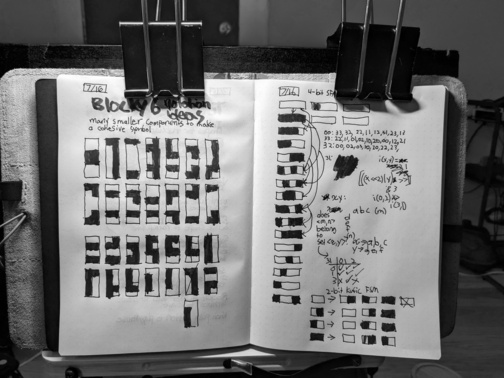Weekly Update 5: Sculpting a Digital Vocal Tract
2023-07-17
Sculpting a Vocal Tract
This week, I found myself sculpting a digital vocal tract. You can see me sculpting it here (yes, there is sound):
The sculpter I built makes use of a Monome Grid and the KN01 knob from BinePad (also known as the NeoKnob). If the vocal tract can be imagined as a long tube, each row on the Grid corresponds to a region on that tube. The rows act as a kind of horizontal slider. As they get larger, the region of that tube gets larger. Various configurations of the regions produce geometries of the vocal tract that "color" an incoming glottal signal going into it with vowel-like timbres. Using the Grid gives me coarse tuning of the tract shape, while the knob provides fine tuning.
This demonstrates one of the advantages to using this particular technique of voice synthesis: malleability. This is one of the only vocal synthesis techniques out there that allows for this interactive kind of sound shaping.
This is not the first time I've built such a thing. In fact, I built an interface for my Grid functionally identical to this one back in 2021 for an earlier version of my system. However, this latest iteration has a few small quality of life improvements added to it. For starters, it controls a better sounding vocal tract. There's also some behind-the-scenes stuff that will make it easier for me to build up sets of tract shapes, which can then be used as phonemes for a babbling pseudo-language.
A notebook of bitmap doodles
At some point, I'd like to name these shapes and use the Grid to display these names. The low density of the Grid forces one to get creative. Letters take too much space, so I figured I'd think logographically and design symbols that can fit the text editor for the Grid I made last week.
It's a work in progress, but here's my notebook sketching out ideas and brainstorming. I think it showcases my typical process pretty well:

Even though these will eventually end up digital bits and pixels, I find sketching things out by hand with ink is a better impedance match for my brain: it moves closer to the rate at which I think about things.
The thought process here moves top to bottom, left to right.
At the top of the left page, I start improvising 2x6 bitmap glyphs. By the start of the second row, some ideas begin to form. I start thinking about symbolically representing an upper and lower path.
The second half of the left page, I switch to 2x4 bitmaps. For some reason, something clicks, and I'm immediately reminded of some of the Generative Kufic-style Calligraphy projects I did a while back, such as kuf and trikuf. These dealt with a set of rules which yielded aesthetically pleasing 1-bit tilesets, which is exactly the sort of thing I want to do here.
The right page here, I'm thinking about rules, systems, and organization. This is where things get a little unhinged. I think I know now what I'm after: combinations of 2x4 tiles that form patterns that conform to some basic aesthetic rules inspired by Kufic calligraphy.
I split the tile in half and rotate it. Instead of 2x4 columns, I now have 4x1 rows. Given a row, I want to know all the valid rows that can come after it. My first instinct was to try and draw this out as a tree structure because I thought it'd be interesting. I should have known that was going to be too tedious to do by hand. I give up visualizing stuff, and start using terser notation. A row can be split in half and turned into a base-4 number: two numbers that are either 0, 1, 2, or 3. I start writing down a table for this with an ad-hoc method. I give up after a while.
At some point, it occurs to me that this is a Finite State Machine, and I might benefit from writing the entire state machine for just 2 bits instead of 4 bits. I drew this out on the bottom on the right page. For any given 2-bit state, there are 3 possible "kufically correct" states that can follow it. There's an elegance to that. Since there's only 4 possible states, you could define an even smaller table that shows what can't follow any given state (which is 1 state instead of 3), and you could fit it all in 16 bits.
I return to the 4-bit rows. I want an algorithm that produces the possible rows for any given rows. I want to try breaking it up into 2 smaller 2-bit states and using the lookup table I just made. There are a maximum of 9 possible states, but only some of those will yield Kufic correct results. The 4-bit row is split in half to make 2 2-bit rows, but there is a third 2-bit row in the middle to consider as well.
The stuff in the center is me trying to shove things into a 3x3 matrix because matrixes are neat, and define some adhoc "math" notation that will tersely define the operations I'm trying to do. The problem is, I just don't remember how to do matrix operations, and I can't be bothered to look it up. So what is there are scribbled attempts to express what I've been doing manually as a formal algorithm. It is incomplete, in a confusing state, but I think nearly done.
Hopefully when this is done, I'll have a re-usable system for procedurally generating aesthetically pleasing symbols.